
USS Essex was an Enterprise-class wooden-hulled armed naval steam sloop of war. She was built between 1874 and 1876 by Donald McKay at the Kitter Naval Yard of East Boston, Massachusetts. She was commissioned on 3 October 1876 by the United States Navy. On 23 December 1930 Essex was sold for scrap, and on 14 October 1931 she was taken to the beach just outside Duluth Harbor where they set fire to her; she eventually burned to the waterline. On 14 April 1994 the remains of Essex were listed on the National Register of Historic Places. Her partially surviving hulk is significant because she is the only known remnant of the work of master shipbuilder McKay.
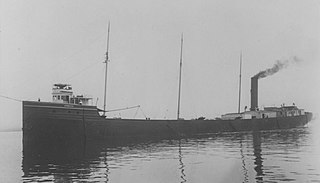
SS Appomattox was a wooden-hulled, American Great Lakes freighter that ran aground on Lake Michigan, off Atwater Beach off the coast of Shorewood, Wisconsin in Milwaukee County, Wisconsin, United States in 1905. On January 20, 2005 the remnants of the Appomattox were listed on the National Register of Historic Places.

Edna G is a tugboat which worked the Great Lakes and is now preserved as a museum ship. Edna G was built by the Cleveland Shipbuilding Company in 1896 for the Duluth and Iron Range Railroad at a cost $35,397.50. She was named for the daughter of J. L. Greatsinger, president of the railroad.
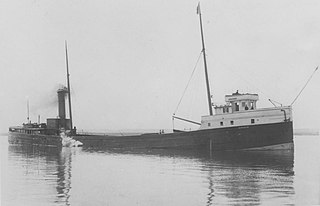
The SS Marquette was a wooden-hulled, American Great Lakes freighter built in 1881, that sank on Lake Superior, five miles east of Michigan Island, Ashland County, Wisconsin, Apostle Islands, United States on October 15, 1903. On the day of February 13, 2008 the remains of the Marquette were listed on the National Register of Historic Places.

Luna is a historic tugboat normally berthed in Boston Harbor, Massachusetts. Luna was designed in 1930 by John G. Alden and built by M.M. Davis and Bethlehem Steel. She is listed on the National Register of Historic Places and is a U.S. National Historic Landmark. In 1985, the Luna was designated as a Boston Landmark by the Boston Landmarks Commission.

The Sport was a tugboat, built in 1873 and wrecked in 1920 in Lake Huron, in the United States. The wreck site, designated 20UH105, was listed on the National Register of Historic Places in 1992.

SS Robert Wallace was a wooden-hulled American bulk freighter that served on the Great Lakes of North America from her construction in 1882 to her sinking in 1902 on Lake Superior near the town of Palmers, St. Louis County, Minnesota, United States. On November 17, 1902 shortly after leaving Superior, Wisconsin with a cargo of iron ore, Robert Wallace sprang a leak and sank. Her wreck was found in 2006, and on October 14, 2009, the wreck of Robert Wallace was listed in the National Register of Historic Places.

Australasia was a wooden-hulled American Great Lakes freighter that served on the Great Lakes of North America between her construction in 1884 to her burning and sinking in 1896. On October 18, 1896, while loaded with coal, the Australasia sank in Lake Michigan near the town of Sevastopol, Door County, Wisconsin, United States, after burning off Cana Island. On July 3, 2013, the wreck of the Australasia was added to the National Register of Historic Places.

The George Spencer was a wooden lake freighter that sank on along with her schooner barge Amboy on Lake Superior, near Thomasville, Cook County, Minnesota in the Mataafa Storm of 1905. On April 14, 1994, the wrecks of the Spencer and the Amboy were listed on the National Register of Historic Places.

The SS Lakeland was an early steel-hulled Great Lakes freighter that sank on December 3, 1924, into 205 feet (62 m) of water on Lake Michigan near Sturgeon Bay, Door County, Wisconsin, United States, after she sprang a leak. On July 7, 2015, the wreck of the Lakeland was added to the National Register of Historic Places.

The SS Atlanta was a wooden hulled Great Lakes steamer that sank in Lake Michigan off the coast of Cedar Grove, Wisconsin, United States, after a failed attempt of her being towed to shore ultimately killing 5 out of her 7 crew members on board. Her wreckage still remains at the bottom of the lake, and on November 6, 2017, the wreck of the Atlanta was listed on the National Register of Historic Places.
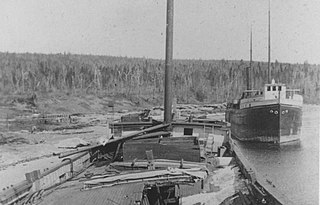
The AmboyandGeorge SpencerShipwreck Site is an archeological shipwreck site which consists of the wrecks of the wooden bulk freighter George Spencer and the wooden schooner-barge Amboy. Both vessels were wrecked during the Mataafa Storm of 1905. In 1994 the site was added to the National Register of Historic Places.

SS Selah Chamberlain was a wooden-hulled Great Lakes freighter that sank in Lake Michigan in 1886, 6 miles (10 km) off the coast of Sheboygan, Sheboygan County, Wisconsin, United States after being rammed by the steamer John Pridgeon Jr. with the loss of five lives. On January 7, 2019, the wreck of Selah Chamberlain was listed on the National Register of Historic Places, and was given the reference number 100003288. She was the first shipwreck listed on the National Register of Historic Places in 2019.
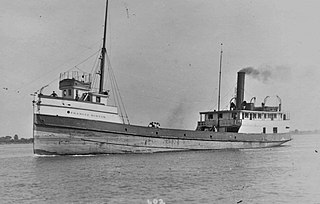
The SS Francis Hinton was a wooden-hulled steam barge that sank in a gale off the coast of Manitowoc, Wisconsin, on Lake Michigan in 1909 while heavily laden with a cargo of lumber. On December 16, 1996, the wreck of the Francis Hinton was listed on the National Register of Historic Places.

SS S.C. Baldwin was a wooden-hulled steam barge built in 1871, that capsized in a storm on August 26, 1908, on Lake Michigan, off Two Rivers, Wisconsin, United States, with the loss of one life. On August 22, 2016 the remnants of S.C. Baldwin were listed in the National Register of Historic Places as reference number 16000565.

The SS J.M. Allmendinger was a wooden-hulled steam barge built in 1883, that ran aground during a storm on November 26, 1895, on Lake Michigan, off the coast of Mequon, Ozaukee County, Wisconsin, United States. On October 11, 2018, the remains of J.M. Allmendinger were listed on the National Register of Historic Places.

Thomas Friant was a wooden-hulled ferry that served on the Great Lakes from her construction in 1884 to her sinking in 1924. In January 1924, while gillnetting out of Two Harbors, Minnesota in Lake Superior, she was holed by ice, and sank with no fatalities. In 2004 her wreck was discovered in over 300 feet (91 m) of water in pristine condition. The wreck of Thomas Friant was listed on the National Register of Historic Places in 2019.

SS Pere Marquette 18 was a steel-hulled Great Lakes train ferry that served on Lake Michigan from her construction in 1902 to her sinking in 1910.
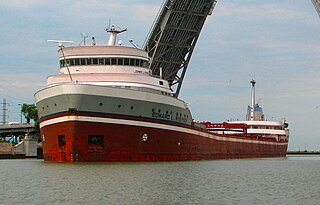
SS Edward L. Ryerson is a steel-hulled American Great Lakes freighter that entered service in 1960. Built between April 1959 and January 1960 for the Inland Steel Company, she was the third of the thirteen so-called 730-class of lake freighters, each of which shared the unofficial title of "Queen of the Lakes", as a result of their record-breaking length. She was not only the last steam-powered freighter built on the lakes but also the last one that was not a self-unloader. Since 2009, she has been in long-term layup in Superior, Wisconsin. She is one of only two American-owned straight deck lake freighters, the other being John Sherwin, built in 1958.

Robert C. Pringle, originally named Chequamegon, was a wooden-hulled American tugboat that sank without loss of life on Lake Michigan, near Sheboygan, Wisconsin, on June 19, 1922, after striking an obstruction.






















